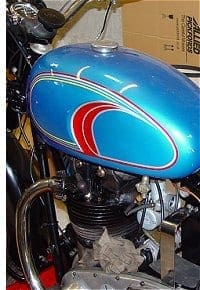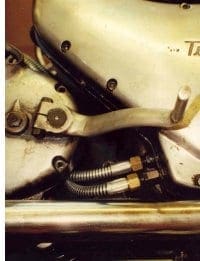In which starting proves to be such sweet sorrow. During the long months of an Ariel Huntmaster rebuild, Frank Westworth encounters a whole new technique for strengthening a single leg…
Where were we? Oh yes. I’d just understood that the Toastmaster’s primary chaincase was never going to be oil-tight, and that there was no point in worrying about it. So I’m not. But I will take it apart again once the bike’s complete and re-seal it. Probably. Possibly…
But the completion of the primary side unleashed another possibility. A truly scary prospect. A step so tremendous that lesser mortals would surely quake with fear! It meant that I could … start the engine.
Enjoy more RealClassic reading in the monthly magazine.
Click here to subscribe & save.
This is good. Getting an engine running for the first time since a bike comes into The Shed is a great goal. And an easily identifiable goal, unlike the vagaries involved with The Great Oil Tank Hunt, for example, or The Heroic Quest For Mudguards, both of them sagas which could easily fill a thousand pages; tales of dark deeds in the middle of Gloucestershire, of postal promises unfulfilled, of… you get the idea.

For an engine to run, it needs several things. In the case of the Toastmaster, none of these was actually present and even faintly correct when I got the bike. Oh, sorry. I exaggerate. It had pistons, valves and approximate compression. The other things an engine needs if it is to burst into prolonged active life include sparks, fuel, air and oil. Let’s get to grips with setting all these simple things together in the appropriate place and let’s aim for a first kick start!
At this point, I should perhaps apologise to the Ariel Owners’ Club’s e-listers, because they’ve heard all this before. In fact, I should publicly thank them for their wisdom, patience and humour, because without them, well, I wouldn’t be where I am today. In fact I would most likely be a guest of Her Majesty’s Excellent Institutions for the Gibbering Insane.
Sparks, then. No probs. Rebuilt (aka entirely new, but let’s pretend) magneto from Sean at CMES. Coupled to the timing gears via a fine and very nice brand new automatic timing device from those most splendid folk who you see at the big jumbles but whose name I cannot at the moment remember. I came close to that Excellent Institute, y’see, and my memory is plainly blanking some of the most painful episodes!
Timing the spark is easy enough; shove an appropriately scribed spoke down the spark plughole, set the pistons at the right point, and fit the timing device at full advance. Easy. Done it a thousand times. ‘hem. Kick over engine: vast fat sparks. Kick cat in revenge for spark erosion of finger tips. Resolve to fit plug cap and plug next time I test the spark.
Fuel. Easy. Brand new Monobloc from Surrey Cycles, who thoughtfully supply their carbs with the correct jetting – assuming that you remember to tell them what bike it’s for. ‘Can I have a carb for my Ariel, please, Mister?’ produces a certain glazed expression, I noticed.

I like to be careful when fitting new carbs. So many mysterious misfires happen because the new carb’s new slides stick (to each other or to the carb body), or because the joint twixt carb and cylinder head is bad, too often because there is the gunge of ages on the two studs which locate said carb, making it impossible to get an air seal. Ariel, like BSA with their derivative and relatively poorly-built A10s, made things worse by fitting a drip guard to the carb/head joint. In theory, this is to stop the engine catching fire when fuel pours onto the magneto, but in practice as many Ariels and A10s catch fire as any other bike (as seen here, in fact) and the silly tin drip guard is more likely to be bowed than either carb flange or head flange, thus making air leaks more likely, and starting more difficult.
This in turn encourages myocardial infarction, by the way, so if you see your Better Half bending your drip guard, check that she’s not just upped your life insurance.

More fuel. Fuel gets to the carb from a fuel tank. Now that may sound like a fatuous comment, but in the Toastmaster’s case, neither of my fuel tanks held fuel. Due to holes. This is unhelpful. However, a fine chap by the name of Van Tran had sold me a gloriously psychedelic BSA B25 petrol tank (gold metalflake with swoopy silver swirls: we did things properly in the Seventies), and that sat easily upon the Toaster’s handsome heavyweight frame, and its fuel outlet was in the right place. So that’s fine, then. The new carb’s new fuel filter should strain out the worst of the metalflake residue…
Sparks and fuel, then. What’s next? Oil. Steal a pair of new oil pipes from John Budgen (then discover that I already had a new set from Draganfly, which I had somehow both forgotten and mislaid: they surfaced immediately after I fitted Mr Budgen’s pipes, of course), and fit them.
Oil tank. Rush cheerily to The Big Pile Of Shiny Refinished Bits and pick up oil tank. Sprint to the parts washer to flush out the filth and oily mess. Remove blasted oil filler cap (you don’t think I’d be stupid enough to pass a tank on to Redditch Shotblasters without sealing all its orifices, now do you? Be afraid; be very afraid…) and discover two amazing things. First the 1959 oil tank hadn’t been cleaned out. Ever. Why didn’t I do this before the blasting and powder coating? Stupidity, most like. Because if I had…

…I would have noticed that the filter was inside the tank (as you’d expect) and that the filter had been destroyed by the fatal conflagration, and had dived in its various component parts into the primordial ooze which lives at the bottom of old oil tanks.
Some day, when Humanity and all other life has vanished from this planet, new life will inevitably start in the bottom of an old Britbike oil tank. The gloop in there is astounding stuff.
But I digress. Gentle Reader, I shall spare you my 50,000 word opus on the various and several designs of oil tanks fitted to Ariels. Let us just say that there are several. This is important if you are trying to make your project bike original, as indeed I was (cunningly ignoring here the new frame, replacement wheels, etc). I wanted to re-use the original oil tank, but once the magic parts washer had cleared all the filth from inside it, it was plain that all was not well.
The very last oil filter fitted by Selly Oak to their heavyweights is not like those they fitted before. Why Ariel changed the oil filter and oil tank design immediately before they gave up building 4-strokes altogether is a mystery. It would make a good question on Mastermind, or maybe a subject for a post-graduate thesis, but it was plain irritating to me at the time.
Because I could not get the filter out of the tank. The mesh bit (bright and shiny and clean, thanks to the parts washer) was rattling about within, and despite hooks, magnets, sticky stuff on a stick and several hours of profane shaking I could not remove it.

I consulted the Ariel Club’s e-list. Was it safe to simply leave the mesh in there? After all, all the oil passed through it anyway, so…
A resounding ‘NO’ came back. Sigh. I need another oil tank.
So I bought one at a Shepton Mallet autojumble, discovered that it was plumbed differently to the original, and realised that it was for a side-valve (no take-off for the rocker oil feed, see, Sherlock). I realised this after I’d fitted it, of course.
So I bought another oil tank from a Cheltenham jumble. This one had no filters at all, and despite being plumbed with the rocker feed coming from the wrong side of the pump (so it’s presumably from a single or a KH) I connected it up anyway. Desperation breeds desperate deeds.
So we have fuel, sparks and fresh golden oil.
Let’s kick…
…some weeks later, after exhausting the patience of all the Ariel Club’s e-listers, appealing in the pages of A Certain Magazine for help and timing tools, and exhausting my own extensive vocabulary of swear words, I was reaching the point where I was contemplating Suicide By Application Of Thor (King of Hammers) To Cranium. I had timed the ignition so often that I could do it in my sleep. I had drained and re-filled the fuel tank. I had replaced the BSA fuel tank with a Matchless fuel tank in case the Toaster carried some obscure racial hatred of BSAs (and who could blame it?). I had worn through two new kickstart rubbers. I had boxes of handy timing devices and had bought a new dictionary of swear words. The Toaster had rewarded all this effort by kicking back, twice, and misfiring loudly, once. What to do?
Then, one day, bored and frustrated, and hating the whole world, I stomped down to The Shed, turned on the fuel and kicked savagely at the Ariel to relieve my tension. It started. Just like that. Sounds very well. Sounds like a new engine.
I turned it off. And kicked again. It started again. No smoke. Few rattles.
Ariels? Wonderful bikes. I don’t care what anyone else thinks…
Advert
 Enjoy more RealClassic reading in the monthly magazine. Click here to subscribe.
Enjoy more RealClassic reading in the monthly magazine. Click here to subscribe.

